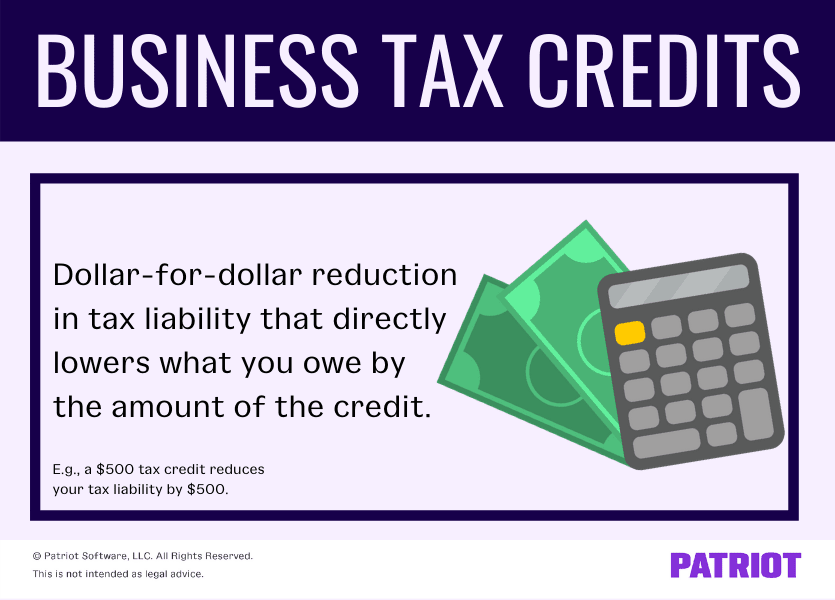If you’re like most taxpayers, you look for every possible deduction when filing your tax return for business. One way to lower your tax liability is to claim business tax credits. And due to the coronavirus pandemic, there are also a number of temporary tax credits for employers to claim.
Read on to learn what is a tax credit. Plus, find out what types of credits are available for individuals, employers, and businesses.
What is a tax credit?
A tax credit is a dollar-for-dollar amount of money individuals and business owners can use to reduce their tax liability. Tax credits directly lower what you owe in taxes by the amount of the credit. There are a number of tax credits individuals and businesses can claim—if you meet certain requirements.

Tax credits can incentivize business owners to take actions that benefit employees, the environment, and the greater good. Likewise, individuals can enjoy tax credits for taking certain actions, such as continuing education, adopting, and making energy-saving home improvements.
So, how do tax credits work? There are two types of tax credits:
- Nonrefundable: You can only lower your tax liability to zero. You cannot receive a refund off of a nonrefundable tax credit. However, you may be able to carry over some nonrefundable tax credits and apply them to future tax years.
- Here’s a little nonrefundable tax credit example. Let’s say you have a tax liability of $3,000 and receive a nonrefundable tax credit of $3,500. Even though the tax credit is more than your liability, you do not receive a $500 refund.
- Refundable: You can receive a refund if your tax credit is more than your tax liability.
- Let’s say you have a tax liability of $3,000 and receive a refundable tax credit of $3,500. You would receive a $500 refund.
If you’re eligible for both refundable and nonrefundable tax credits, apply the nonrefundable tax credits first.
Small business tax credit vs. deduction
Both tax credits and deductions are tax incentives that reduce tax liability. But, deductions and credits are not interchangeable.
Small business tax deductions reduce your total taxable income. On the other hand, business tax credits reduce your tax bill. So, what exactly does that mean?
Let’s say you have $100,000 of taxable business income. A tax deduction of $2,000 would drop your taxable income to $98,000 while a tax credit would directly lower your tax bill by $2,000.
Tax credits for small business owners are more substantial reductions than deductions. Because credits lower your tax bill and not your taxable income, a tax credit would offer greater savings than a deduction of the same value.
Business tax credits and beyond
Want to see whether you’re eligible to claim a tax credit and potentially slash your taxes? Read on to get an overview of tax credits available for:
- Businesses
- Employers during COVID
- Individuals
Business tax credits
Most business tax credits are part of the general business credit. You can carry forward general business credits from previous years.
There are a number of credits available to businesses. Here are just a few common business tax credits you might be eligible to claim:
- Small employer health insurance tax credit
- Paid family and medical leave tax credit
- Disabled access credit
- Work opportunity credit
- Employee retention credit for employers affected by qualified disasters
- Credit for employer-provided childcare facilities and services
You can claim these credits when you file your business tax return. Here’s a brief overview of the above tax credits.
Small employer health insurance tax credit
Small employers with fewer than 50 full-time equivalent employees may choose to provide health insurance by enrolling in the Small Business Health Options Program (SHOP).
Some employers who enroll in a SHOP plan are eligible for the small business health care tax credit.
This credit applies to employers with fewer than 25 full-time equivalent employees who pay at least 50% of employee premiums. Your employees’ average salaries must also be below a certain threshold.
This credit is worth up to 50% of your premium costs. Keep in mind that this credit is only available for two consecutive tax year credit periods.
Paid family and medical leave tax credit
Employers who voluntarily offer paid family and medical leave between 2021 – 2025 might be eligible for the employer credit for paid family and medical leave.
To qualify, you must choose to offer paid FMLA leave to all eligible employees, pay at least 50% of the employee’s wages, provide at least two weeks of paid FMLA to full-time employees, and have a written policy in place.
Your tax credit amount depends on the percentage of wages you give to employees while they are on leave. The credit ranges from 12.5% – 25%.
Keep in mind that this tax credit is not the same as the COVID-19 paid sick and family leave tax credit.
Disabled access credit
If you incur expenses to provide access to employees or customers with disabilities, you may be eligible for the disabled access credit.
To qualify, you must have gross receipts below $1 million and 30 or fewer full-time employees. Eligible expenses include removing barriers and acquiring equipment for individuals with disabilities.
You can receive a tax credit of up to $5,000.
Work opportunity credit
If you hire individuals from qualifying groups who have faced employment barriers, you might be eligible for the work opportunity credit.
Examples of qualifying employees include:
- Veterans
- Individuals with disabilities
- Ex-felons
- Long-term unemployment recipients
You can claim the credit for first- and second-year wages paid to these employees. The amount you can claim depends on the employee you hire.
Employee retention credit for employers affected by qualified disasters
Have you been impacted by a qualifying declared disaster (e.g., tornadoes, hurricanes, earthquakes, etc.)? If so, you may be able to claim this employee retention tax credit.
To qualify, you must continue to pay an employee’s wages despite not being able to operate your business due to disaster damage. The credit is worth 40% of up to $6,000 of qualifying wages, per employee.
Keep in mind that this employee retention credit is not the same as the COVID-19 Employee Retention Credit.
Credit for employer-provided childcare facilities and services
If you foot the bill for certain childcare facilities and resource and referral expenses, you may be able to claim this tax credit.
To qualify, you must spend money acquiring, constructing, rehabilitating, or expanding an eligible property for childcare.
This tax credit is worth 25% of your qualifying childcare facility expenses, plus 10% of qualifying childcare resource and referral expenses. The maximum credit amount is $150,000 per year.
Employer tax credits during COVID
Thanks to the coronavirus, there are a few tax credits employers can claim on the employer tax return form. Keep in mind that these employer tax credits are temporary credits established by emergency legislation.
Qualifying employers can claim:
- Employee Retention Credit (ERC)
- Paid leave credits (sick and family)
Unlike business and individual tax credits, you do not use your income tax return to claim the Employee Retention Credit and paid leave credits. Instead, use the employer tax return (Form 941 or 944).
Employee Retention Credit
The Employee Retention Credit was established under the CARES Act. Eligible employers can claim the ERC for keeping employees on payroll during the coronavirus pandemic.
The ERC is a refundable credit worth up to $7,000 per employee, per quarter. It is available during 2020 and 2021.
Paid leave credits
Eligible employers who offer employees paid sick and family leave for qualifying coronavirus-related situations can claim a tax credit. This emergency paid leave tax credit offsets the costs of providing the leave.
The amount of the tax credit you can claim is equivalent to the amount of the paid leave you give each employee. Therefore, the tax credit depends on the employee’s pay, how many days they use the paid leave, and the purpose of the leave:
- (Self) Paid sick leave, up to $511 per day for 10 days: Employees who are quarantined or isolated due to the coronavirus or vaccine receive their regular wages
- (Others) Paid sick leave, up to $200 per day for 10 days: Employees who are caring for someone who is quarantined or isolated due to the coronavirus receive two-thirds of their regular wages
- Paid family leave, up to $200 per day for 12 weeks: Employees who are caring for a child whose school or childcare center is closed receive two-thirds of their regular wages
Paid leave tax credits 2021 are available through September 30, 2021.
Individual tax credits
Businesses and employers aren’t the only ones who can claim tax credits. Individuals can also lower their tax liability by claiming tax credits.
The IRS makes tax credits available for individuals in a number of categories, including:
- Family and dependent credits (e.g., child and dependent care credit)
- Income and savings credits (e.g., earned income tax credit)
- Homeowner credits (e.g., low-income housing credit)
- Health care credits (e.g., premium tax credit)
- Education credits (e.g., lifetime learning credit)
For more information about available tax credits for individuals, check out the IRS’s website.
How to apply for business tax credits
To claim business tax credits, complete Form 3800, General Business Credit. Attach this form to your business tax return (e.g., Schedule C, Form 1065 and Schedule K-1, Form 1120, or Form 1120-S).
You must also attach additional forms for each type of credit you claim. Part III of Form 3800 identifies which additional forms you need to include.
Here are a few of the business tax credits and corresponding forms you must attach to Form 3800:
| Business Tax Credit | Form to Attach to Form 3800 |
|---|---|
| Small employer health insurance tax credit | Form 8941 |
| Paid family and medical leave tax credit* | Form 8994 |
| Disabled access credit | Form 8826 |
| Work opportunity credit | Form 5884 |
| Employee retention credit for employers affected by qualified disasters* | Form 5884-A |
| Credit for employer-provided childcare facilities and services | Form 8882 |
*Keep in mind that these tax credits are not coronavirus-related credits. Again, claim ERC and paid leave credits related to coronavirus legislation on your employer tax return.
For a full list of business tax credits and the forms to use to apply for them, consult the IRS.
Want to claim business tax credits? You need supporting documents to back up your claims. Track your expenses with Patriot’s online accounting software. View summaries of your business expenses, vendor payment details, and more. Get your free trial now!
This article has been updated from its original publication date of March 14, 2019.
This is not intended as legal advice; for more information, please click here.
